Troph Tropes:
Trophic levels are used to classify organisms by their feeding habits. Ya know, (taxonomically speaking) ya gotcha auto/heterotroph bisection; then ya got yer herbivores, carnivores, and detritivores- Basic food-web stuffs. In this field study, specimens were were indexed by family and classified by their tropic guilds.
Trophic guilds take this notion of feeding habits a step further, suggesting a prevailing link between morphological and behavioral adaptations that maximize the effectiveness of a preferred feeding strategy (Alexander, p.255), as illustrated in this cool drawing of various nematodes and their mouth parts.
 [3]
[3]
So, even though the guild ascription ostensibly privileges specialization, you can see in the legend pulled from this study's data, most benthic macroinvertebrates (BMIs) are generalists.
*To better compare this information with the predictions made by the River Continuum, only organisms strictly classified as shredders, collectors, predators, and/or grazers were counted. Below are each groups' characteristics and a few predictions. [There's also a spiffy chart I yanked for quick reference below the RCC diagram.]
Trophic guilds take this notion of feeding habits a step further, suggesting a prevailing link between morphological and behavioral adaptations that maximize the effectiveness of a preferred feeding strategy (Alexander, p.255), as illustrated in this cool drawing of various nematodes and their mouth parts.
 [3]
[3]
Because each feeder supposedly has a concomitant feeding strategy, they can therefore be order into groups. Hence! Functional Feeding Groups.
So, even though the guild ascription ostensibly privileges specialization, you can see in the legend pulled from this study's data, most benthic macroinvertebrates (BMIs) are generalists.
*To better compare this information with the predictions made by the River Continuum, only organisms strictly classified as shredders, collectors, predators, and/or grazers were counted. Below are each groups' characteristics and a few predictions. [There's also a spiffy chart I yanked for quick reference below the RCC diagram.]
Functional Feeding Groups:
Shredders munch on decaying organic matter (leaves, twigs, etc.) This coarse particulate organic mater (or CPOM) is directly correlated with canopy cover and riparian vegetation. SO. There should be a high percentage of shredders in headwaters (or a low order stream).
Scrapers and grazers rasp algae from the substrate. Algae needs sunlight to propagate. SO. There should be a fair percentage of scrapers and grazers in the middle reaches of a river (or a mid order stream) where there is less canopy cover.
Collectors have morphological and behavioral adaptations best suited to filter, snag, and catch fine particulate organic matter (or FPOM)-- material further broken down or generated by shredders, scrapers, and grazers, such as fine leaf litter, bacteria, and feces. These guys are found in all stream reaches, but their populations tend to increase in habitats not suitable for shredders and scrapers. (*Consider the paramount limiting factors, i.e. the substrate, oxygen demand...)
Predators feed on other organisms. They have morphological and behavioral adaptations suited for capturing prey. Predators are similarly found in all habitat types, but their populations tend to be small relative to other feeding groups.
Shredders munch on decaying organic matter (leaves, twigs, etc.) This coarse particulate organic mater (or CPOM) is directly correlated with canopy cover and riparian vegetation. SO. There should be a high percentage of shredders in headwaters (or a low order stream).
Scrapers and grazers rasp algae from the substrate. Algae needs sunlight to propagate. SO. There should be a fair percentage of scrapers and grazers in the middle reaches of a river (or a mid order stream) where there is less canopy cover.
Collectors have morphological and behavioral adaptations best suited to filter, snag, and catch fine particulate organic matter (or FPOM)-- material further broken down or generated by shredders, scrapers, and grazers, such as fine leaf litter, bacteria, and feces. These guys are found in all stream reaches, but their populations tend to increase in habitats not suitable for shredders and scrapers. (*Consider the paramount limiting factors, i.e. the substrate, oxygen demand...)
Predators feed on other organisms. They have morphological and behavioral adaptations suited for capturing prey. Predators are similarly found in all habitat types, but their populations tend to be small relative to other feeding groups.
*To better compare this information with the predictions made by the River Continuum, only organisms strictly classified as shredders, collectors, predator, and/or grazers were counted.
Refs--
Alexander, David, and Rhodes W. Fairbridge. Encyclopedia of Environmental Science. Dordrecht: Kluwer Academic, 1999. Print.
Engevold, Paul. PBI and Trophic Structure. N.p.: n.p., n.d. Print.
Engevold, Paul. Stream Comparisons - The Parts Equal the Whole. N.p.: n.p., n.d. Print.
Vannote, Robin L., G. Wayne Minshall, Kenneth W. Cummins, James R. Sedell, and Colbert E. Cushing. "The River Continuum Concept." Canadian Journal of Fisheries and Aquatic Sciences 37.1 (1980): 130-37. Print.
Images
[1] Personal Painting
[3] Vector Legend, Personal Illustration
[4] Vector Stream with RCC Projections, Personal Illustration
[5] Chart reproduced from, PBI and Trophic Structure, Engevold, Paul
 [1]
[1]

 [5]
[5]
No comments:
Post a Comment